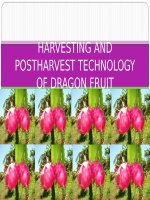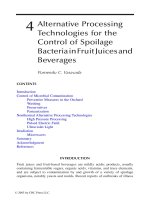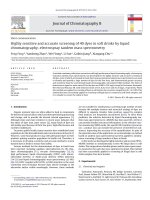Chemistry and technology of soft drinks and fruit juices 3e by philip r ashurst
Bạn đang xem bản rút gọn của tài liệu. Xem và tải ngay bản đầy đủ của tài liệu tại đây (7.87 MB, 426 trang )
Chemistry and Technology of Soft Drinks
and Fruit Juices
Chemistry and
Technology of
Soft Drinks and
Fruit Juices
Edited by
Philip R. Ashurst
T h i rd E ditio n
This edition first published 2016 © 2016 by John Wiley & Sons, Ltd.
Registered Office
John Wiley & Sons, Ltd, The Atrium, Southern Gate, Chichester, West Sussex, PO19 8SQ, UK
Editorial Offices
9600 Garsington Road, Oxford, OX4 2DQ, UK
The Atrium, Southern Gate, Chichester, West Sussex, PO19 8SQ, UK
111 River Street, Hoboken, NJ 07030‐5774, USA
For details of our global editorial offices, for customer services and for information about how to
apply for permission to reuse the copyright material in this book please see our website at
www.wiley.com/wiley‐blackwell.
The right of the author to be identified as the author of this work has been asserted in accordance with the
UK Copyright, Designs and Patents Act 1988.
All rights reserved. No part of this publication may be reproduced, stored in a retrieval system, or
transmitted, in any form or by any means, electronic, mechanical, photocopying, recording or otherwise,
except as permitted by the UK Copyright, Designs and Patents Act 1988, without the prior permission of
the publisher.
Designations used by companies to distinguish their products are often claimed as trademarks. All brand
names and product names used in this book are trade names, service marks, trademarks or registered
trademarks of their respective owners. The publisher is not associated with any product or vendor
mentioned in this book.
Limit of Liability/Disclaimer of Warranty: While the publisher and author(s) have used their best
efforts in preparing this book, they make no representations or warranties with respect to the accuracy
or completeness of the contents of this book and specifically disclaim any implied warranties of
merchantability or fitness for a particular purpose. It is sold on the understanding that the publisher is
not engaged in rendering professional services and neither the publisher nor the author shall be liable for
damages arising herefrom. If professional advice or other expert assistance is required, the services of a
competent professional should be sought.
Library of Congress Cataloging‐in‐Publication data applied for
ISBN: 9781444333817
A catalogue record for this book is available from the British Library.
Wiley also publishes its books in a variety of electronic formats. Some content that appears in print may not
be available in electronic books.
Cover image: © azureforest/DigitalVision Vectors
Set in 9.5/13pt Meridien by SPi Global, Pondicherry, India
1 2016
Contents
Contributors, xv
Preface, xvi
1 Introduction, 1
P.R. Ashurst
1.1 Overview, 1
1.2 Soft drinks, 1
1.2.1 Ready‐to‐drink products, 2
1.2.2 Concentrated soft drinks, 2
1.2.3 Legislation, 3
1.2.4 Product types, 4
1.2.5 Development trends, 6
1.2.6 Nutrition, 7
1.2.7 New product trends, 8
1.3 Fruit juices, 8
1.3.1 Processing technology, 9
1.3.2 Adulteration, 10
1.3.3 Other processes, 12
1.3.4 Nutrition, 12
1.4 Packaging, 13
1.5 Summary, 14
References and further reading, 14
2 Trends in beverage markets, 15
E.C. Renfrew
2.1 Introduction, 15
2.2 Definitions, 15
2.3 Beverage consumption trends, 16
2.3.1 Bottled water, 17
2.3.2 Carbonated soft drinks, 17
2.3.3 100% juices, nectars and fruit drinks, 19
2.3.4 Energy drinks, 19
2.3.5 Ready‐to‐drink (RTD) tea and ready‐to‐drink coffee, 20
2.3.6 Coffee, 20
2.3.7 Tea, 21
2.3.8 Beer, 21
2.3.9 Wine, 22
2.3.10 Milk and flavoured milks, 22
v
vi Contents
2.4
2.5
2.6
2.7
Consumption charts, 23
Regions and markets, 25
Market share charts, 26
Main drivers in consumption, 28
2.7.1 The search for ‘natural’, 28
2.7.2 Adult soft drinks, 29
2.7.3 Protein drinks, 29
2.8 Conclusion, 29
3 Fruit and juice processing, 31
B. Taylor
3.1 Introduction, 31
3.2 Fruit types, 32
3.2.1 Botanical aspects and classification of fruit types, 32
3.2.2 Harvesting considerations for berry, citrus, pome,
stone and exotic fruits, 35
3.3 Fruit types for processing, 36
3.3.1 Pome fruits, 36
3.3.2 Citrus fruits, 38
3.4 General comments on fruit juice processing, 39
3.4.1 Processing of ‘fleshy’ fruits, 40
3.4.2 The use of enzymes in fruit juice processing, 43
3.4.3 Extraction of citrus juices, 46
3.5 Juice processing following extraction, ‘cleaning’ and clarification, 48
3.5.1 Juice concentration by evaporation, 49
3.5.2 Freeze concentration, 50
3.5.3 Hyper‐ and ultrafiltration, 50
3.6 Volatile components, 51
3.6.1 Spinning cone column, 52
3.6.2 Composition of fruit juice volatiles, 53
3.7 Legislative concerns, 54
3.7.1 European fruit juice and nectars directive and associated
regulations, 54
3.7.2 AIJN Guidelines, 56
3.7.3 Labelling regulations and authenticity, 57
3.7.4 Juice in the diet – ‘five‐a‐day’, 58
3.8 Quality issues, 58
3.8.1 Absolute requirements, 58
3.9 In conclusion, 62
References and further reading, 64
4 Water and the soft drinks industry, 65
T. Griffiths
4.1 Usage of water in the industry, 65
4.2 Sources of water, 66
Contents vii
4.2.1 Water cycle, 66
4.2.2 Surface water, 67
4.2.3 Ground water, 67
4.3 Quality standards relating to water, 68
4.3.1 UK legislative standards, 68
4.3.2 Internal and customer standards, 68
4.4 Processing water, 69
4.4.1 Required quality, 69
4.4.2 Starting quality, 72
4.4.3 Processing options, 75
4.5 Analytical and microbiological testing of water, 83
4.5.1 Chemical tests, 83
4.5.2 Microbiological tests, 84
4.6 Effluents, 84
4.6.1 Potential contaminants of water waste, 84
4.6.2 Use of ‘grey’ water, 85
4.6.3 Clean‐up and reuse of effluents, 85
Further reading, 87
References, 87
5 Other beverage ingredients, 88
B. Taylor
5.1 Introduction, 88
5.2 Factors influencing development of the industry, 88
5.3 The move towards standardisation, 91
5.4 The constituents of a soft drink, 94
5.5 Water, 94
5.5.1 Requirements, 94
5.5.2 Quality of fresh water, 96
5.5.3 Water hardness, 96
5.5.4 Water treatment, 96
5.5.5 Water impurities and their effect, 97
5.6 Acidulents, 98
5.6.1 Citric acid, 98
5.6.2 Tartaric acid, 99
5.6.3 Phosphoric acid, 100
5.6.4 Lactic acid, 101
5.6.5 Acetic acid, 101
5.6.6 Malic acid, 101
5.6.7 Fumaric acid, 101
5.6.8 Ascorbic acid, 102
5.7 Flavourings, 102
5.7.1 Flavourings and legislation, 104
5.7.2 Flavourings in beverage application, 106
viii Contents
5.7.3 Water‐miscible flavourings, 106
5.7.4 Water‐dispersible flavourings, 107
5.8 Colours, 112
5.9 Preservatives, 115
5.9.1 Microorganisms and beverages, 116
5.9.2 Sulphur dioxide, 117
5.9.3 Benzoic acid and benzoates, 119
5.9.4 Sorbic acid and sorbates, 119
5.10 Other functional ingredients, 120
5.10.1 Stabilisers, 120
5.10.2 Saponins, 120
5.10.3 Antioxidants, 121
5.10.4 Calcium disodium EDTA, 121
5.11 Food safety, 122
5.12 Future trends, 123
Further reading and references, 125
6 Non‐carbonated beverages, 126
P.R. Ashurst
6.1 Introduction, 126
6.2 Dilutable beverages, 127
6.2.1 Overview, 127
6.2.2 Nomenclature, 127
6.2.3 Ingredients, 128
6.2.4 Manufacturing operations, 137
6.2.5 Filling and packaging, 139
6.2.6 Product range, 140
6.3 Ready‐to‐drink non‐carbonated products, 140
6.3.1 Overview, 140
6.3.2 Formulations, 140
6.3.3 Special problems, 140
6.3.4 Manufacturing and packing, 141
6.3.5 Packaging types, 142
6.4 Fruit juices and nectars, 142
6.4.1 Processing, 142
6.4.2 Packaging, 144
Further reading, 145
7 Carbonated beverages, 146
D. Steen
7.1 Introduction, 146
7.2 Carbon dioxide, 147
7.3 Carbon dioxide production, 148
7.3.1 Fermentation, 148
7.3.2 Direct combustion, 148
Contents ix
7.3.3 Quality standards, 149
7.3.4 Delivery to the customer, 149
7.3.5 Precautions, 150
7.4 Carbonation, 152
7.4.1 Basic considerations, 152
7.4.2 Carbonation measurement, 154
7.5 Syrup preparation, 156
7.6 De‐aeration, 157
7.7 Carbonators, 158
7.8 Filling principles, 160
7.8.1 Gravity filler, 161
7.8.2 Counter‐pressure filler, 163
7.8.3 Other filler types, 167
7.8.4 Clean‐in‐place systems, 169
7.9 Process control, 171
7.10 Future trends, 172
Further reading, 173
8 Processing and packaging, 174
R.A.W. Lea
8.1 Introduction, 174
8.2 Juice extraction, 174
8.3 Blending, 175
8.3.1 Batch blending, 176
8.3.2 Flip‐flop blending, 176
8.3.3 Continuous blending, 176
8.4 Processing, 177
8.4.1 Flash pasteurisation, 177
8.4.2 Hot filling, 178
8.4.3 In‐pack pasteurisation, 179
8.4.4 Aseptic filling, 179
8.4.5 Chilled distribution, 181
8.4.6 Summary, 181
8.5 Control of process plant, 181
8.6 Factory layout and operation, 182
8.7 Hazard Analysis Critical Control Points, 186
8.8 Good manufacturing practice, 186
8.9 Cleaning in place, 187
8.10 Packaging, 188
8.11 Conclusion, 191
9 Packaging materials, 192
D. Rose
9.1 Introduction, 192
9.2 Commercial and technical considerations, 193
x Contents
9.2.1 General considerations, 193
9.2.2 Packaging materials, 195
9.3 Processing, 197
9.3.1 Cold‐filling, 197
9.3.2 In‐pack pasteurising, 197
9.3.3 Hot‐filling, 198
9.3.4 Aseptic filling of bottles, 198
9.3.5 Liquid nitrogen injection, 202
9.4 Bottles, 202
9.4.1 Glass, 202
9.4.2 Polyethylene terephthalate, 203
9.4.3 High‐density polyethylene, 207
9.4.4 Polypropylene, 207
9.4.5 Polyvinyl chloride, 207
9.4.6 Plastic properties, 208
9.5 Closures, 209
9.5.1 Metal roll‐on or roll‐on pilfer‐proof closures, 209
9.5.2 Vacuum seal closures, 210
9.5.3 Plastic closures, 211
9.5.4 Crown corks, 213
9.6 Cans, 213
9.6.1 Metal bottles, 218
9.6.2 Plastic cans, 218
9.7 Cartons, 218
9.8 Flexible pouches, 221
9.9 Multipacks, 222
9.10 Secondary packaging, 223
9.11 Pack decoration, 224
9.12 Environmental considerations, 225
9.13 Conclusions, 228
Acknowledgements, 230
10 Analysis of soft drinks and fruit juices, 231
D.A. Hammond
10.1 Introduction, 231
10.2 Laboratory accreditation, 234
10.3 Sensory evaluation, 236
10.4 Water, 237
10.5 Sweeteners, 239
10.5.1 Analysis of natural sweeteners, 240
10.5.2 Analysis of high‐intensity sweeteners, 245
10.6 Preservatives, 249
10.6.1 Benzoic and sorbic acids, 249
10.6.2 Sulphur dioxide, 251
10.6.3 Dimethyldicarbonate, 252
Contents xi
10.7
10.8
10.9
Acidulants, 252
Carbonation, 256
Miscellaneous additives, 257
10.9.1 Caffeine, 257
10.9.2 Quinine, 258
10.9.3 Other additives, 258
10.9.4 Fibre analysis, 259
10.9.5 Herbal drinks, 260
10.9.6 Osmolality, 261
10.10 Analysis of colours used in soft drinks, 261
10.10.1 Assessment of colour, 263
10.10.2 Synthetic colours, 265
10.10.3 Natural pigments, 267
10.11 Vitamin analysis in soft drinks systems, 272
10.11.1 Fat‐soluble vitamins, 274
10.11.2 Vitamin B class, 274
10.11.3 Vitamin C, 275
10.11.4 Vitamin analysis using immunological
procedures, 275
10.12 Methods used to detect juice adulteration, 276
10.13 Methods used to assess the juice or fruit content of soft
drinks, 280
10.14 Conclusions, 282
References, 283
11 Microbiology of soft drinks and fruit juices, 290
P. Wareing
11.1 Introduction, 290
11.2 Composition of soft drinks and fruit juices in relation
to spoilage, 291
11.3 Background microbiology – spoilage, 293
11.3.1 Sources, 293
11.3.2 Yeasts, 294
11.3.3 Bacteria, 295
11.3.4 Moulds, 297
11.4 Microbiological safety problems, 299
11.4.1 Escherichia coli, 299
11.4.2 Salmonella, 299
11.5 Preservation and control measures, 299
11.6 Sampling for microbial problems, 301
11.7 Identification schemes and interpretation, 301
11.7.1 Sample isolation, 301
11.7.2 Non‐molecular methods, 302
11.7.3 Molecular identification, 302
11.8 Brief spoilage case studies, 303
xii Contents
11.9 Conclusions, 304
References, 306
Further reading, 309
12 Functional drinks containing herbal extracts, 310
E.F. Shaw and S. Charters
12.1 History, 310
12.2 The extraction process, 313
12.2.1 Extraction heritage, 314
12.3 An extraction operation, 320
12.3.1 Raw materials, 321
12.3.2 Extraction, 323
12.3.3 Organic extracts, 329
12.3.4 Extract costs, 329
12.4 Extract characteristics and their problems, 331
12.4.1 Specifications, 331
12.4.2 Stability, 331
12.4.3 Hazing, 332
12.4.4 Availability, 333
12.5 Incorporation of extracts in beverages, 333
12.5.1 Fruit juice‐based and fruit‐flavoured drinks, 333
12.5.2 Mineral‐water based and flavoured water drinks, 334
12.5.3 Carbonated and dilutable drinks, 334
12.5.4 Energy and sports drinks, 334
12.5.5 Regulatory issues, 335
12.6 Some commonly used herbs, 337
References, 354
13 Miscellaneous topics, 356
P.R. Ashurst and Q. Palmer
13.1 Introduction, 356
13.2 Nutrition, 356
13.2.1 Nutritional components, 357
13.2.2 Calculation and declaration of nutrition information, 360
13.3 Sports drinks, 363
13.3.1 Definition and purpose, 363
13.3.2 Physiological needs, 363
13.3.3 The absorption of drinks, 365
13.3.4 Formulation, 366
13.4 Niche drinks, 369
13.4.1 Alcoholic‐type drinks, 369
13.4.2 Energy drinks, 370
13.4.3 Functional drinks or nutraceuticals, 371
13.4.4 Powder drinks, 372
Contents xiii
13.5
Dispensed soft drinks and juices, 372
13.5.1 Introduction, 372
13.5.2 Pre‐mix and post‐mix compared, 373
13.5.3 Equipment, 373
13.5.4 Outlets, 375
13.5.5 Hygiene, 375
13.5.6 Post‐mix syrup formulation, 376
13.5.7 Post‐mix syrup packaging, 377
13.6 Ingredient specifications, 378
13.6.1 Why have specifications?, 378
13.6.2 What a specification should include, 378
13.6.3 Preparation of a specification, 378
13.6.4 Supplier performance, 379
13.7 Complaints and enquiries, 380
13.7.1 Complaints, 380
13.7.2 Enquiries, 382
13.8 Health issues, 383
13.8.1 Soft drinks and dental damage, 383
13.8.2 Effect of colourings and preservatives, 386
13.8.3 Obesity, 387
13.9 Alternative processing methods, 388
13.9.1 Microwave pasteurisation technology, 388
13.9.2 High‐pressure processing, 393
13.9.3 Irradiation, 395
References, 396
Index, 398
contributors
Philip R. Ashurst
Dr. P R Ashurst and Associates, Ludlow, UK.
Stuart Charters
Bwlch Garneddog, Gwynedd, UK.
Tony Griffiths
Quality Systems Consultant, Chelmsford, UK.
David A. Hammond
Fruit Juice and Authenticity Expert, Wolverhampton, UK.
Robert A.W. Lea
GlaxoSmithKline, Weybridge, UK.
Quentin Palmer
Schweppes Europe, Watford, UK.
Esther C. Renfrew
Market Intelligence Director, Zenith International Ltd, Bath, UK.
David Rose
A Pkg Prf. Packaging Development Manager, Britvic Soft Drinks, Hemel Hempstead, UK.
Ellen F. Shaw
Flavex International Limited, Kingstone, UK.
David Steen
Casa Davann, Murcia, Spain.
Barry Taylor
Firmenich (UK) Ltd., Wellingborough, UK.
Peter Wareing
Principal Food Safety Advisor, Leatherhead Food Research, Leatherhead, UK.
xv
Preface
The first edition of this book was published in 1998, and the second in 2005.
Now, some ten year later, this third edition is published. Its aim remains that of
providing an overview of the science and technology of soft drinks and fruit
juice products, and of the industries that manufacture and support them. The
book is written for students and graduates in food science, chemistry and micro
biology, those who are working in the beverage industry or its supply chain, or
simply for any reader who wishes to know more about the subject.
There can be few, if any countries, in the world that do not have a plant
manufacturing these products, as they have a universal appeal to most con
sumers of all ages. Soft drinks are available in virtually every city, town and
village on the planet, as well as in aircraft and ships. The range of flavours and
packaging formats is remarkable, as producers are always attempting to s timulate
new interest.
There is no single definition for soft drinks but, in general terms, they are
essentially non‐alcoholic beverages, excluding dairy products, tea and coffee.
Fruit juices are, by definition, self‐explanatory, although the term is often
misused to cover products that contain a proportion of juice.
Soft drinks and fruit juices have, from time to time, been the subject of criti
cism by various sections of the health community. In the past, this has been
mainly because of the risk of tooth erosion. There is now an issue of obesity in
almost all developed countries, as well as associated diseases, such as type 2
diabetes. Sugar consumption is cited as a significant contributory factor.
At the time of writing, there is considerable pressure on beverage manufac
turers to reduce, or even remove, the sugar content of products. The issue is
complicated by the wrong assumption that is often made, that the sugars occur
ring naturally in fruit juices are added to the products. Further confusion also
arises because, in the United Kingdom and some other countries, public health
bodies promote fruit juices as part of a healthy diet. Beverages, however, are
far from the only source of sugar/carbohydrate intake, and it is important to
recognise that they continue to play an important part in hydration and enjoy
ment and, particularly for fruit juices, are part of a balanced and healthy intake
of nutrients.
The fundamental composition of soft drinks changes little, although manufac
turers continually strive for new flavours and ingredients. The main changes that
occur relate mostly to processing and packaging innovations and, in consequence,
this book has a similar format to earlier editions. The opening introductory
xvi
Preface xvii
chapter sets the scene and is followed by a review of beverage markets. This
second chapter includes references to beverage markets other than soft drinks
and fruit juices, which helps put the various product categories into perspective.
Chapter 3 is an updated review of fruit processing and fruit juices, while
chapter 4 is a new inclusion, dealing with the most important, but most easily
overlooked, common ingredient – water. The following two chapters are updates
from the second edition and deal, respectively, with a comprehensive review of
ingredients and non‐carbonated soft drinks.
Chapters 7 and 8 are inclusions from the second edition and deal, respec
tively, with the particular issues of carbonated drinks and typical processing and
packaging operations. Although the second edition included a chapter on pack
aging materials, the corresponding contribution in this edition is a completely
new inclusion.
Another area where there is almost constant development is that of analytical
chemistry. Consumers, manufacturers and enforcement bodies are all concerned
to ensure that products are of consistent quality, have correct label information,
are free from harmful substances and, in some cases, ingredients that may relate
to particular dietary needs. In the case of juices, authenticity is also of great sig
nificance. Chapter 10 is a very comprehensive review of this subject.
Although soft drinks and fruit juices are very rarely the source of any serious
food health issues, product spoilage as a result of yeast or fungal contamination
is probably the most common source of complaint and concern. The important
inclusion on microbiology is also a completely new contribution dealing with
this topic.
Earlier reference was made to the constant search by manufacturers for new
ingredients. Botanical extracts such as infusions have been sources of flavour and
herbal remedies over many centuries, and these are increasingly featured as inclu
sions in a wide range of beverages. Label claims on the remedial effects of such
inclusions are, in most countries, highly regulated, in order to avoid confusion
with medicines. Consequently, unless used as sources of flavour (e.g. ginger), the
amounts of such botanical inclusions are usually very limited, and often rely
on their listing on a product label for effect. The newly written chapter on such
components is a valuable addition on this subject.
The final chapter is an attempt to incorporate a wide range of miscellaneous
topics that are likely to be of significance to readers.
What has been excluded? One obvious topic is that of legislation relating to
these products. In the United Kingdom and EU countries, there is now little
compositional limitation, apart from constraints on some additives, with reliance
being placed on label information to enable consumer choice. It is this area of
labelling, including product claims, that is now perhaps of particular signifi
cance. Legislation changes frequently, and varies from country to country,
although general approaches are becoming commonplace across the globe. For
readers for whom this topic is important, there are many sources of up‐to‐date
xviii Preface
information which may be consulted. For obvious reasons, a book such as this
cannot offer the range and timeliness of such information.
Other topics excluded are those of nutrition and environmental matters and,
again, there are many comprehensive sources of this information available to
enable readers to obtain the information they require.
Readers will find, in some instances, that there is overlap between chapter
contents, but these have been left in the manuscript because of the significance
of the topics within the respective chapters. There are also likely to be other top
ics that readers have not found covered and, for these and other shortcomings,
the editor takes full responsibility.
Because of continuous commercial and other pressures, it is becoming
extremely difficult to find authors with the knowledge, expertise and the ability
to take time out of their day job to contribute to a work such as this. Essentially,
this is the reason why this third edition has taken so many years to produce. The
editor is greatly indebted to all the authors, who are all acknowledged experts in
their respective fields, for their valuable contributions.
It is to be hoped that the reader will find this third edition to be a worthy and
useful successor to earlier works, and that it meets the needs of those seeking to
learn more about this important industry.
Philip R. Ashurst
Chapter 1
Introduction
Philip R. Ashurst
Dr. P R Ashurst and Associates, Ludlow, UK
1.1 Overview
Fruit juices and soft drinks are available in essentially the same form almost
anywhere in the world. From polar bases to the tropics, and from the largest
developed nations to small and less developed countries, soft drinks and fruit
juices are available in bottles, cans, laminated paper packs, pouches, cups and
almost every other form of packaging known.
This chapter outlines what soft drinks are, describes the various types of
products available and sets the scene for later chapters, which deal with the
more specialised aspects of the chemistry and technology of these products.
1.2 Soft drinks
What are soft drinks? There is no single definition available, but it is generally
accepted that they are sweetened, water‐based beverages, usually with a balancing acidity. They are flavoured by the use of natural or artificial materials, are
frequently coloured, and often contain an amount of fruit juice, fruit pulp or
other natural ingredients. The predominant ingredient is water – often ignored
and frequently maligned – and it should be considered that the primary function
of soft drinks is hydration. The sweetness and other characteristics enhance the
enjoyment of consumption and make the products more appealing to consumers.
They are, in some respects, secondary, and yet have importance in the provision
of energy and some of the minor essential nutrients needed to meet daily
requirements.
It is generally accepted that the description of soft drinks excludes tea, coffee,
dairy‐based beverages and, until recently, alcohol. However, in many countries,
the production of ‘soft’ drinks containing alcohol is growing. Many see this as an
undesirable trend because, traditionally, the taste of alcoholic beverages has
Chemistry and Technology of Soft Drinks and Fruit Juices, Third Edition. Edited by Philip R. Ashurst.
© 2016 John Wiley & Sons, Ltd. Published 2016 by John Wiley & Sons, Ltd.
1
2 Chapter 1
been associated with adulthood. The blurring of the edges between the markets
and tastes for alcoholic drinks and soft drinks appears to facilitate an easy transition
for children and young people to the consumption of alcohol. It should be noted
that, in many soft drinks, small amounts of alcohol (less than 0.5% alcohol by
volume (ABV)) may be present as a consequence of alcohol being used as a
solvent for many flavourings. Small amounts of alcohol may also be present in
fruit juices.
There are two basic types of soft drinks: the so‐called ready‐to‐drink (RTD)
products that dominate the world market and the concentrated, or dilute‐to‐taste,
products that are still important in some markets. These include syrups and
so‐called squashes and cordials.
Whether RTD or dilutable, soft drinks characteristically contain water, a
sweetener (usually a carbohydrate, although artificial sweeteners are increasingly important), an acid (citric or malic and phosphoric in colas are the most
common), flavouring, colouring and preservatives. There is a large range of
additional ingredients that can be used for various effects.
1.2.1 Ready‐to‐drink products
This sector accounts for the largest volume of soft drinks production, and is
divided into products that are carbonated – that is, they contain carbon dioxide –
and those that are not. Carbonated RTD soft drinks dominate the world market,
and detailed consumption trends are discussed in Chapter 2 of this volume.
The market for carbonated soft drinks is dominated by two giant brands of
cola drinks that, together with their associated brand names, account for just
over half the world’s consumption of such products.
Non‐carbonated RTD beverages have shown some considerable growth in
recent years, mainly because of the availability of aseptic packaging forms. Non‐
carbonated drinks that rely on chemical preservation, or hot‐pack/in‐pack
pasteurisation, often suffer from a number of potential problems, including
rapid deterioration of flavour and colour.
1.2.2 Concentrated soft drinks
Concentrated soft drinks became very important during the Second World War,
and in the early years following that conflict. Many were based on concentrated
orange juice, which was widely available as a nutritional supplement in the
United Kingdom, packed in flat‐walled medicine bottles.
The main markets for concentrated soft drinks developed mainly in the
United Kingdom and its former empire. The products became universally known
as ‘squashes’ or ‘cordials’, and became enshrined as such in UK food legislation
in the 1960s.
Another very important development was the production of citrus comminutes. These were produced by mixing together, in appropriate proportions,
the juice, peel components and essential oils of citrus fruits, and comminuting
Introduction 3
the mixture in a suitable mill. The resulting product delivered a more intense
flavour and cloud than could be obtained from juice alone, and allowed the
creation of ‘whole fruit drinks’, which have dominated the concentrates market
in the United Kingdom over the past 40–50 years.
1.2.3 Legislation
It is not the intention of this chapter to cover legislation affecting soft drinks in
any detail – not least, because it varies from country to country, and there is
often a continuous variation of legislation within countries.
Legislation is, however, important from an historical perspective. For example,
in the United Kingdom, the Soft Drinks Regulations 1964 (as amended) codified
the products according to the way in which the industry was then organised,
and set into law definitions not only of ‘soft drinks’, but also of many different
product types, such as crushes, squashes and cordials. These names subsequently
became generic household names in the United Kingdom and in many parts of
the English‐speaking world.
The above regulations were probably among the most proscriptive compositional statutes that existed for any food products in the United Kingdom, and for
beverages anywhere in the world. As well as defining soft drinks, they laid down the
requirement for minimum levels of sugars in certain product types, the maximum
levels of saccharin (the only artificial sweetener then permitted) and the minimum
levels of comminuted fruit and fruit juices that defined the best‐known product
categories. These regulations were eventually revoked in 1995.
The current trend is to move away from compositional legislation, to a much
freer approach in which carbohydrates and other nutritional components can be
used at will, and additives are taken from ‘positive’ lists of functional components. Other ingredients are frequently controlled by negative usage (i.e. they
must not be present, or must not exceed closely defined limits).
This move to remove controls on formulations is now backed by informed
labelling that contains increasing amounts of information for the consumer. This
approach is now used widely throughout the world, with only relatively minor
variations from country to country.
At the time of writing, the relevant European Union regulations (EU
1169/2011) require that a food which includes fruit juices and soft drinks must
be labelled, and that labels must contain the following information:
1 the name of the food;
2 the list of ingredients;
3 any ingredient or processing aid listed in Annex II (of the regulations), or
derived from a substance or product listed in Annex II causing allergies or
intolerances that is used in the manufacture or preparation of the food and is
still present in the finished product, even if in an altered form;
4 the quantity of certain ingredients or categories of ingredients (see below);
5 the net quantity of the food;
4 Chapter 1
6 the date of minimum durability or the use‐by date;
7 any special storage conditions and or conditions of use;
8 the name or business name and address of the food business referred to in
Article 8(1);
9 the country of origin or place of provenance, where provided for in Article 26;
10 instructions for use where it would be difficult to make use of the food without
such information;
11 In beverages containing more than 1.2% of alcohol by volume of alcohol,
the actual alcoholic strength by volume;
12 a nutritional declaration.
It will be apparent that not all of the above will apply to fruit juices and soft
drinks, but the declaration of the quantity of key ingredients (fruit or fruit juice
in soft drinks) became law through earlier quantitative ingredient declaration
regulations in Europe. Where artificial sweeteners and carbohydrates are used
together, an appropriate statement is necessary. A warning about the product
being a source of phenylalanine must be incorporated when aspartame is used
as a sweetener.
Other additional regulations may also apply, and the above information should
only be considered as a general guide. There is a wealth of additional information
on this topic available on the internet. Readers requiring more specific information should consult appropriate authorities.
Because, in most countries, legislation is a rapidly changing sphere, it is
essential for those formulating, producing and marketing soft drinks to update
themselves regularly as regards the legislation of consumer countries, and to
ensure label compliance.
1.2.4 Product types
1.2.4.1 Ready‐to‐drink products
Historically, soft drinks were refreshing beverages that copied or extended fruit
juices. Fruit juices typically have around 10–12% naturally occurring sugars,
mostly with a pleasant balancing acidity that varies from about 1% down to 0.1%.
It is, therefore, not surprising that soft drinks were typically formulated to
contain around 10–11% sugar content, with about 0.3–0.5% of added acid
(usually citric acid). The simplest form of beverage contained such a mix of these
basic nutritional components in water, with flavouring, colouring and chemical
preservatives added as necessary.
With the addition of carbon dioxide to render the product ‘sparkling’, ‘effervescent’ or ‘fizzy’, the manufacturer had a lemonade or similar product. With
the addition of fruit juice to a level of 5–10%, a pleasing effect of both taste and
appearance could be achieved. Such products were typically described as ‘fruit
juice drinks’, ‘fruit drinks’ or ‘crushes’ (a reserved description in the old UK
regulations). Various other additions could be made, including vitamins and
minerals, clouding agents and foaming agents, and plant extracts.
Introduction 5
RTD beverages are mostly carbonated (i.e. contain carbon dioxide). This, as
well as giving sensory characteristics, provides some antimicrobial effect, especially against yeasts and moulds. Carbon dioxide is effective against yeasts,
because it tends to suppress the production of more CO2 as a by‐product of the
fermentation of sucrose to ethanol. In addition, it deprives moulds of the oxygen
that most require for growth. Good hygiene standards are the norm in most soft
drink‐bottling operations today, and it is possible to produce carbonated drinks
without chemical preservatives, by flash‐pasteurising the syrup before it is mixed
with carbonated water. The risk of microbiological spoilage is then low but,
where large containers are used, the risk is increased because of the potential for
subsequent contamination as product is removed and the container ullaged.
Carbon dioxide levels vary widely, and are usually expressed as ‘volumes of
CO2 gas’ (i.e. the volume of carbon dioxide contained in solution in one volume
of product). Lightly carbonated products will contain around 2.0–3.0 volumes
of the gas, while moderate carbonation usually refers to about 3.5–4.0 volumes,
and high carbonation levels are around 4.5–5.0 volumes. Large bottles that are
likely to become partially full will be relatively highly carbonated, while mixer
drinks contain among the highest carbonation levels, because the resultant
mixture (e.g. gin and tonic) needs to have a satisfactory residual level of dissolved
carbon dioxide.
RTD beverages are also produced in non‐carbonated forms. The most popular
current form of these is distributed in aseptic card/foil laminate packs, such as
Tetra Pak or Combibloc. These drinks are typically unpreserved, and come in
volumes of 200–330 ml.
An alternative form of non‐carbonated beverage comes in form‐fill‐seal plastic containers, which are typically square or round section cups, with a foil or
plastic laminate lid. Such products are difficult to produce to a quality that will
satisfactorily compete with the shelf life of aseptic foil/laminate packs. Form‐fill‐seal
containers leave their contents vulnerable to oxidative degradation, are especially
at risk of mould spoilage, and require the use of preservatives. The packs are now
increasingly produced in aseptic conditions and are free from preservatives.
Some manufacturers produce RTD products at drinking strength, but this is
wasteful of plant and requires large‐volume production tanks. The usual
approach is to manufacture a syrup or concentrated form of the beverage, which
is then diluted with water and carbonated as required. Alternatively, the syrup,
which can be flash‐pasteurised, can be dosed into bottles which are then topped
up with water. This is known as the ‘post‐mix’ method. Where the alternative
(‘pre‐mix’) method is employed, syrup and water are mixed in the correct proportions in special equipment, prior to bottle filling.
1.2.4.2 Dilutables
As indicated in Section 1.2.2, some markets are substantial consumers of concentrated soft drinks. These products are purchased in concentrate form by









